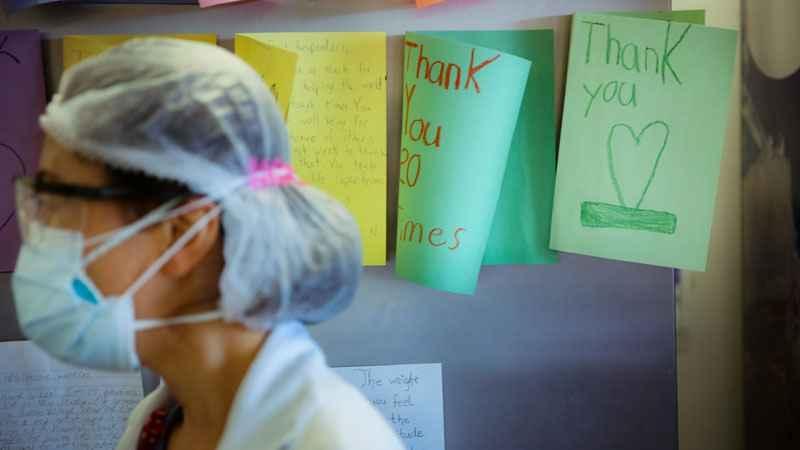Health care providers face staffing challenges amid increase in demand
[anvplayer video=”5050770″ station=”998122″]
Amid a year and a half of unprecedented challenges, health care systems across the metro are dealing with an increase in demand.
Patients are finally making appointments they delayed during the peak of the pandemic, trauma cases increased during the summer and others are seeking treatment for illnesses. The Minnesota Hospital Association said those factors combined with an increase in COVID-19 patients is leading to a higher volume of patients.
More than 96% of intensive care unit hospital beds and more than 98% of non-ICU hospital beds are now full in the metro, according to Minnesota Department of Health data.
“When you have such high numbers of admissions, you’re not going to have enough staff,” said Mary Turner, the president of the Minnesota Nurses Association.
Summers always create staffing challenges as nurses go on vacation, Turner said. This year, however, the system is already stressed.

In this May 29, 2020, file photo, letters of thanks from students adorn the walls of a break room that was set up for workers to decompress from the stresses of caring for COVID-19 patients at Elmhurst Hospital, in New York.[AP/Robert Bumsted, File]
“We had a lot of nurses that retired when this pandemic hit,” she said. “A lot of nurses decided to go on call because, with the pandemic, they had young children, so it became difficult so you have people cutting hours.”
Other nurses left the profession altogether, according to Turner.
“What happens is you’ve got nurses working more shifts than they maybe should,” she said. “The agency can’t come fast enough.”
Agency nurses work under short-term contracts to help fill staffing needs at health care facilities.
During an interview last year, Triage Staffing CEO John Maaske told 5 EYEWITNESS NEWS they were seeing a 130% increase in demand by August and September 2020.
“We kind of thought to ourselves, ‘Can this grow even bigger than it was at that time?’” Maaske said on Tuesday. “I would’ve said no because it was ridiculously high, but today, believe it or not, it’s actually bigger.”
“Every single week we’re seeing job demand increase and probably our demand has grown 30%, maybe even 35% in the last four to five weeks.”
He said their placements have increased by about 40% in the last month. According to Maaske, ICU nurses and respiratory therapists are among the most in-demand positions.
“Certainly the delta variant is creating some complexity to the overall healthcare market,” he said. “But just the old backlog of cases that were pushed off last year are now kind of coming to the forefront and they’ve been doing that all year. All the elective procedures that were put off in 2020 have certainly been served in 2021, and that is probably creating as much of a demand as the delta variant is.”
Texas has the greatest need for staff right now, Maaske said, while Minnesota is towards the middle of the pack.
“It’s definitely been on the uptick,” he said. “We’re seeing pockets that are seeing much higher demand than what you’re seeing in Minnesota.”
He told us he is worried about burnout among healthcare workers nationwide. It’s a reality Turner has seen firsthand as a COVID-19 ICU nurse.
“On my floor, this is kind of like our fourth wave of COVID,” Turner said. “We’ve got a case of nurses going, ‘I can’t do this again,’ and that is being felt all over the country. … We are a profession that has been pushed to the limit for way too long.”
5 EYEWITNESS NEWS reached out to the major health care providers in the metro but no one was made available for an interview.
A spokesperson for HealthPartners said in an email, "Like every other health care system in the state, HealthPartners is experiencing a smaller candidate pool and a very competitive job market."
Children’s Minnesota shared this statement:
"At Children’s Minnesota, our employees are our most important resource. Staffing has been an issue for many years in many healthcare organizations and the pandemic made it worse. Even in the face of a challenging labor market, it’s our collective duty to be here as the kid experts for all children and families in Minnesota and the region. That is why we are evaluating new strategies to recruit all roles that are critical to supporting the care of our patients and their families. We encourage anyone wanting to make an impact to join our team and help us build a better future for all children."
In a statement, the Minnesota Hospital Association said summer is usually a time with increased demand on health care providers, and this year is no exception.
"Many hospitals and health systems are seeing an increased volume of patients requiring care – mostly due to general increased demand. Summer is generally a busy trauma season, and that is holding true this year. We are also seeing patients coming in with the usual health issues like stroke, heart conditions and mental health. People may be taking time during the summer to make appointments for care that they had put off during the winter and spring. In addition, we are seeing a steady increase in COVID-19 patients and we are remaining watchful of the trends. Our hospitals and health systems continue to provide excellent care to patients when and where they need it."